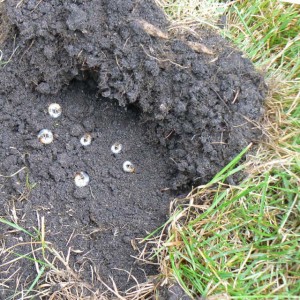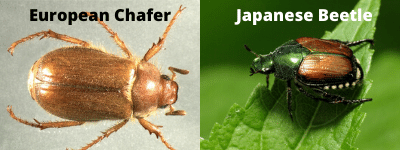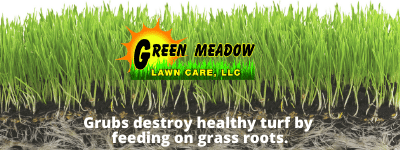How Do I Know If I Have Grubs?
Have you ever noticed dead areas around your yard during summer? Patches of grass that you could roll back like a freshly laid carpet of sod? If so, you are familiar with the damage that grubs can cause to a lawn.
Grubs can not only be a nuisance but they can attract another pests - like moles.
Many people have found success with using specific products and control methods but there are a few things you should know before buying or implementing a treatment program.

Questions Answered:
- What is a grub?
- How do grubs destroy lawns?
- What are the Signs of Grub Damage?
- When and How do I treat for Grubs?
- What can I do on my own to get rid of grubs?
What is a Grub?
- Grubs are the larvae of beetles. They most commonly evolve into Japanese Beetles (June Bugs) or European Chafers.
- Grubs have a milky white color with C-shaped bodies.

How Do Grubs Destroy Lawns?
-
Grubs feed on grass roots causing sections of your turf to die.
-
Grubs attract other pests. Many birds, skunks and raccoons feed on grubs and can cause damage when digging for them.
-
Grubs attract moles. Moles feed on grubs and will leave tunnels in the process.
-
A matured grub will turn into a beetle that will emerge from the soil and eat leaves of your other prized plants.
- When grubs evolve to beetles, they will mate and lay more eggs.

What are Signs of Grub Damage?
-
Irregular shaped, dead areas in your yard. If you peel your grass back, these areas of lawn will roll back like a carpet.
-
Roots: When you pull back the dead areas, you will notice that the roots of the grass were eaten.
-
Mole holes: Grubs are a favorite snack of moles. If you notice mole holes or tunnels in your lawn, there's a good chance you have grubs around as well.
-
Weeds: When grubs eat grass roots, this weakens your grass. Weakened grass has less resistance to weeds.
-
Spongy feeling grass. You will notice a sponge-like texture when you walk on damaged areas of your turf.
-
Edges: Grubs feed on the edges of the dead areas and work their way into your healthier, greener grass.
Pro tip: To see if you have active grubs pull back a section of grass and you will see what looks like little, white worms. These are your grubs!
When and How do I Treat for Grubs?
Once you have identified that you in fact have grubs - here's what you can do to get rid of them.- To control grubs in the spring or fall use carbaryl or trichlorfon.
- Spread Imidacloprid on your lawn any time between May - Mid August.
- Be sure to read the label so you know what product you are putting down and when the best time is for that specific product.
DIY Grub Control:
- Apply a product that is labeled for active grubs. Products come in either a liquid or granular form so choose whichever product is easiest for you to apply.
- Most curative grub treatments require to be watered into soil in order to get the product down to where grubs reside.
- Read the label for best results and make sure you are always using products correctly.
Now that you know how to identify grubs, how to treat for them, and what they can do to your lawn - you are ready to have a lush lawn year-round without having to worry about grubs destroying all of that hard work you did.
If you ruled out grubs, read more below to see what else could be possibly causing your lawn's health to suffer:
- How Do I Get Rid of Moles In My Yard
- Moles vs Gophers vs Voles
- Tunnels in My Lawn When Snow Melts [Voles?]
- How to Treat for Grubs [Prevent Before its too Late]
- How to Repair Grub Damage
- What Do Moles Eat? It's NOT Just Grubs
- How to Repair Grub Damage
Bottom Line:
To eliminate the possibility of grubs taking over your lawn, plan ahead and apply a grub control treatment each year. Grub control can get expensive, but in the long run it is much more cost effective than having to re-seed your entire lawn.
If you are looking to hire someone, hire someone you trust. Referrals from family, friends, and neighbors are a great way to make sure you won’t be taken advantage of.
Since 2007, Green Meadow Lawn Care has provided homeowners throughout the greater Tolland, Connecticut area with premium fertilization programs, tick control, mosquito management, seeding & aeration and tree & shrub care.
Visit our Learning Center to find out more about how our services can help you or visit our Youtube Channel to view more in our Learning Center Series.
To speak to our Customer Service Manager, please call Dave (view Dave's video bio here) with any questions. Dave has been in the industry for 30 years and is always happy to help with his expert advice.
860-870-5700



